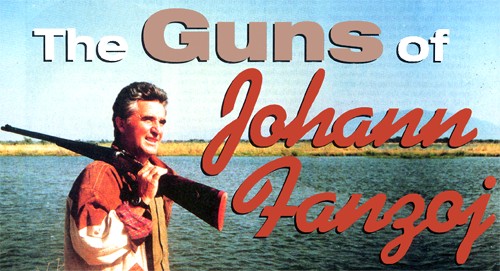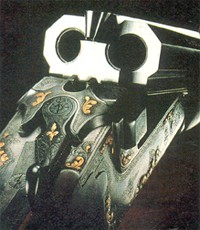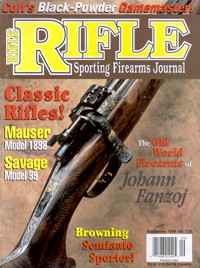
(Pronounced "FAWN-zoy")
Specializing in the creation of extraordinary hunting guns in
the Austrian tradition.
Featuring double rifles, double shotguns, drillings, stalking rifles and
the new Tri-bore gamegun (triple barreled shotgun).
Our only job is to...build our clients the finest guns on earth!
Johann Fanzoj
Master Gunmakers since 1558
Ferlach, Austria
fanzoj@doublegunshop.com
![]()
The Guns of Johann Fanzoj
- A look at Austria’s Master of the Art -
By Dave Scovill of Rifle Magazine*

Not only is Johann Fanzoj one of Ferlach’s most
famous armourers, but he has also
hunted big game all over the world. This side-by-side is the epitome of the African
safari rifle designed for use on dangerous game.
| Growing up in the
timber lands on the west side of the Cascade Mountains in Oregon, I actually laid my hands
on a modern bolt action, a Winchester Model 70 .270 WCF, for the first time in 1958 at the
tender age of 13. Prior to that, the so-called modern bolt action in our house was a Model
1896 .30-40 Krag rifle that some soul had altered somewhat, chopping the forend off just
in front of the front barrel band. The other bolt-action rifle in our house was a Japanese
Arisaka 7.7. None of the other folks in the logging camp had modern bolt-action rifles either. Most were modified Springfields or Model 94 Winchesters. Nobody, and I mean nobody, owned a bolt-action sporter from Winchester or Remington, and I vividly remember why the .270 WCF that Bill Strader, my boss on the French Creek Ranch, owned didn’t have a cocking piece on the rear of the bolt, like the Krag and Springfields. In short, the Winchester Model 70 just didn’t feel or look right, owing the simple fact I had cut my teeth on surplus military rifles, |
 Manufactured
in boxlock style (Anson & Deeley) |
||||||||||||||
| both U.S. and foreign, and I still think the Krag had the
slickest action I have ever laid my hands on, bar none. By comparison the mere act of
closing the bolt on the Model 70 was like dragging a tow chain across a gravel road, and I
wondered secretly why anyone who knew anything about rifles would tolerate such a dubious
ill-conceived affair. The reason for revealing my early prejudice regarding modern bolt-action rifles is simply to demonstrate that, to a certain degree, my ill-gotten opinions reflect what a good number of folks in this country think of foreign rifles. I remember a letter from a reader who stated, “European gun makers don’t know anything about making rifles.” Whew! Every so-called modern rifle that in made in the U.S. is based on the Model 98 Mauser - a product of Germany, which is in Europe. Of course, other rifle designs have their origins in Europe as well, including double rifles, over-and-under rifles, single shots, etc.; they all originated on the other side of the Atlantic. The only thing we can lay claim to is the development of the lever action and a long line of single shots, which most folks in Europe think is little more than a legacy to frontier America - the Indian wars and the Wild West, neither of which has anything to do with serious hunting.
In short, there are apparent prejudices on both sides of the Atlantic, but for different reasons. Rifle manufacturers in this country cater to the demand for increasingly more powerful rifles and tack-driving accuracy. In addition to accuracy, European gunmakers are also concerned with absolute flawless function, fit and finish. So much so, that the craftsmanship that is common among custom riflemakers in Europe has no peer, not in this country. No offense, but this is true nonetheless. As a case in point, I recently had the opportunity to tour Ferlach, Austria. Nowhere else on earth is such a collection of gunsmithing talent as there is in this little town in southern Austria. Neither is there anything that compares to the gunsmithing school (Höhere Technische Bundeslehranstalt Ferlach) where a young man or woman at the age of 15 to 16 can enter a four-year course in firearm design that makes it possible to build a rifle from scratch with hand tools and graduate with a four-year degree, or five-year course in engineering. Upon completion of the four- or five- year course a graduate can build a rifle, any rifle, be it sidelock, boxlock, double rifle, over-and-under, drilling, bolt-action, side-by-side - you name it - with any stock design and then engrave it or provide inlays of gold or silver. If any gunsmith in the U.S. can compete with the average graduate of Ferlach’s gunsmithing school, there is a good chance he graduated from Ferlach. One of Ferlach’s most revered gunsmiths (armourers) is Johann Fanzoj. A walk through Johann’s shop reveals a dazzling array of work in various states of completion, double rifles milled from a single block of steel called (demiblock), over-and-under rifles, drillings (three barrels any combination of which can be a smoothbore or rifled barrel), and the object of interest to most hunters in the U.S. - a beautifully crafted Mauser bolt-action sporter with a classic western stock design. In Johann’s office, the display of finished rifles is fit to honor a collection of arms from a dozen craftsmen, let alone one man. One of the most unique rifles in the Fanzoj collection is a .470 Nitro Express side-by-side rifle with a dolls-head action and demiblock octagon barrels. Other folks might like a more traditional Holland & Holland side-by-side with subdued engraving or lavishly embellished arabesques. If you prefer a 6.5-pound Mauser chambered for the 7x57mm Mauser or a 6.5x75, it’s yours for the asking, complete with monte carlo sporter stock, ebony forend tip and quick release scope mount, just in case you might like to use the three-leaf express sights. (In this country, I have seen quick release mounts on rifles that didn’t even have sights on the barrel - no doubt to swap scopes but not to allow the use of iron sights.) After the tour of the gunsmithing school and Johann Fanzoj's shop in Ferlach, I was offered the opportunity to hunt gamsbuck (chamois) in the historic Alps. Of course, I was flattered by the invitation but had no rifle. Johann quietly sipped on a mug of Austria's finest and offered one of his personal hunting rifles, a little custom Mauser with a Swarovski 6x scope that was chambered for one of the all-time European classics, the 6.5x57mm Mauser. Johann must have seen a hint of hesitation on my face and offered that it printed about one inch high at 100 meters with 140-grain Nosler Partition bullets. I figured that meant a point blank range of nearly 220 yards or so, assuming a muzzle velocity of around 2,400 to 2,500 fps. I was hooked. The next morning before dawn, we traveled to Slovenija (the northern part of the former Yugoslavia) to meet our guides Legai Rado and Sašo Hrovat. After a brief coffee - the Austrians never get in a hurry - we traveled up to the base of the Alps, just south of the Austrian-Slovenijan border, and began the hunt on foot. With Johann's son Hannes in tow, Rado and I worked along the east side of a narrow valley while Johann, Sašo and Jim Morey (president of Swarovski Optiks North America) moved across to the west side of the valley. Before long I sensed Rado knew the gamsbuck were close by - either because he was familiar with their habits, or he had seen some in the area a day or two previously. Either way, he moved ever so slowly, watching the rocky slopes with increasing intensity. Even in North America, when a guide acts like that, the hunter knows action is immediately forthcoming. Sure enough, it wasn't long before Rado pointed out a gamsbuck at what appeared to be 240 to 260 yards up the steep slope. We discussed our options - and the fact that I had never fired the rifle - and decided to move closer. A few minutes later, at a range of 80 yards or so, we hunkered down in a dry wash (at least that's what we call it in Arizona) and waited for the buck to move into clear view. With the buck's chest partially in the open, I watched through the 6x scope, thinking that in a few more minutes I would have the whole animal out in the clear. Rado looked at me quizzically, asking if I wanted to shoot this animal. I said, yes, but I had never seen a gamsbuck in the wild and just wanted to watch a bit longer, assuming the animal didn't spook or start to wander off.
Rado smiled and obviously understood. A minute or two later, with the crosshairs centered low on the buck's chest (the shot was at a relatively steep uphill angle) the little Mauser rifle barked and the gamsbuck staggered then fell and rolled a few yards down the slope. As it turned out, the gamsbuck was a nice trophy, scoring in the Bronze Metal range of 102. Later that morning, Jim Morey bagged another nice animal, but only after a rigorous walk up the challenging slopes. (The Slovenijan Alps are about 6,000 to 7,000 feet elevation, about the same as the high desert plains around Prescott, Arizona.) Following the hunt, we retired to a little chalet at the foot of the mountains as the lengthening shadows moved across the valley. The brief rest before the trip back to Austria offered a unique opportunity to visit with Rado and Sašo, learning more about their country and the people. Like most European countries, hunting is somewhat restricted and largely unavailable to the common folk, and it was plainly obvious that Rado and Sašo enjoyed the opportunity to share their interest in hunting, guiding and game management. Except for some minor language difficulties, it was almost like being in the Colorado Rockies in pursuit of bighorn. Unfortunately, the wonderful day in the Slovenijan Alps came to an end - pressing schedules are a real pain - and we crossed the border on the journey back to Ferlach.
The following day, I made arrangements with Josef Krainer, the managing director of the Association of the Master Gunsmiths in Ferlach, to have some samples of their hammer-forged barrels forwarded to Prescott so that we might mount one or two on rifles and review the end product with our readers. Josef agreed to send two .308 inch barrels and a 6.5mm, which were received a couple months later. We also made arrangements with Dr. Axel Zafoschnig, head of the gunsmithing school's English Department (and our tour guide while visiting the school), to forward a supply of Handloader and Rifle magazines to the students for their use in English class. (Yes, they must learn English, and those we spoke with did exceptionally well.) During our last visit with the Fanzoj family, Johann indicated he would be receptive to the idea of selling his rifles - over-and-unders, side-by-sides and bolt-action sporters - in the United States with appropriate styling modifications to suit the North American tastes in stock design, scope mounts and engraving. Of course, that has been a hang-up with rifle fanciers in the States for years, trying to get the Europeans to make rifles that would appeal to the buyer in the U.S. |
|||||||||||||||
| It has long been apparent that the talent for gunmaking is
largely unchallenged, but like most everything else these days, the devil is in the
details - monte carlo walnut stocks, elegant but limited engraving, basic checkering and
classic stock design, traditional U.S. scopes and mounting systems and, of course,
accuracy. It might also help to understand the Austrian's intense interest in highly engraved and lavish firearms is an extension of their approach to hunting. As in most European countries, hunting has traditionally been the province of the landed gentry - the lords, princes, ministers of governments or kings and emperors who manage the game at their pleasure. The management, of course, is the job of the Jäger, who is employed by the land owner. In most instances, every animal is known, and its ancestry goes back for many years and countless generations. As such, the Jäger knows these animals individually - just as a man who raises horses in the United States is intimately familiar with his animals' lineages. To hunt these animals is an honor, not taken lightly. No commoner would even consider anything to harm the "king's" deer unless, of course, he were an outlaw or poacher. Since the sport of hunting is taken so seriously, with almost a ritual intensity, so are the firearms taken seriously. Nobles don't just hunt with any old rifle. The lavish engraving and finish is the result of respect for the animal, which deserves better than a bullet from a surplus military rifle. It is also important to understand that a Jäger in Europe is a highly respected man who wears his loden green garments for all to see and admire. I am reminded that while hunting on the Fürstenburg estate near Weitra in the summer of 1996, our host Herr Wilhelm Peschke, who was the Bürgermeister (mayor) of the nearby town, was most proud of his heritage as a Jäger (hunter) and forester. As we strolled down the streets of Weitra in our hunting garb, local citizens smiled with respect and greeted us with Guten Tag (good afternoon). Little did they know I was from a mountain town in the once-wild American West half a world away. Neither did they care. From my clothes, they knew I was a hunter. The significance of all this tradition and respect for hunting and the game also suggests that the highly engraved arms are more than an attempt to embellish the sideplates on a Holland & Holland or an over-and-under. Those game scenes represent the intimate relationship between the hunter and the game. It's personal and reflects the gunsmith's skills to show respect for the sport of hunting. So while some of us in North America tend to look down our noses at those lavishly embellished European firearms, it is only out of ignorance for the European respect for the sport of hunting, both the Jäger and the game. It is hunting of the highest order, and the skill to build a firearm to the traditional standards is not taken lightly. For those who are interested in the guns of Johann Fanzoj, contact them
via email at: fanzoj@doublegunshop.com |
Ferlach's Gunsmithing History Since the beginning of the sixteenth century, the production of arms has had its importance for Ferlach. For seven generations the Fanzoj family has contributed to this proud tradition. When Emperor Maximilian I had to fortify the city of Klagenfurt in view of the threat by Turks and Venetians, he called hardworking gunsmiths into the besieged village - today's Ferlach. Water coming down the Karawanken Mountains propelled the blacksmiths' hammers, thick woods made the embers burn in the smiths' hearths, the Carinthian foundries provided the necessary pig iron. But still more important were the skills of the lock makers, barrelsmiths, barrel drillers, stockmakers and armourers. Although the fabrication of military weapons was prevalent at the beginning, hunting arms were always produced, and out of the multitude of specialized professions, by and by, the craft of gunmakers with their own guild system evolved with an examination seal as proof of their severe quality control. When Maria Theresia (empress of Austria) called for Fanzoj's ancestors to come to Ferlach, the Village of gunsmiths had already gained an international reputation. The whole Austrian army was equipped with Ferlach weapons, and international export activities already existed at that time. From small beginnings the Fanzoj family quickly became a respected member of the guild, and when the craftsmen's trade and war equipment no longer fit together, a practicable way was found for the future The Fanzojs became specialists and top-class producers of hunting arms. From generation to generation, a wealth of experience and knowledge was gathered with imperturbable, speedy continuity which nowadays Master Fanzoj uses and augments with thoughtful devotion. The most important aspect thereby is the satisfaction of the client, because satisfied clients have made it possible that hunters all over the world hunt with Fanzoj arms today. Fanzoj's most famous client was certainly Emperor Franz Josef of
Austria. Since style and quality consciousness are no longer as fashionable as before,
things turned out to be more difficult, but also more attractive, as the pleasure of
accomplishing something special for modern customers is an even greater challenge.
Mediocrity became the norm some time ago, but Fanzoj permits his clients and himself to
ignore this development. |
||||||||||||||
 |
Wolfe Publishing 6471 Airpark Drive Prescott, AZ 86301 Phone 800-899-7810 |
| Special thanks to Dave Scovill of Wolfe Publishing for allowing us to reprint this article from Rifle Magazine Issue #179 (September/October 1998). | |
Johann Fanzoj home page at doublegunshop.com
Johann Fanzoj home page Austria
Request more information on Johann Fanzoj Guns & Rifles
![]()
doublegunshop.com home | Welcome | Sponsors | The Gun Rack | The Book Rack | SxS Video Gallery
Enter Our Monthly Lottery | Order or
request more information | Other Useful Information
Double Gun BBS - Question & Answer Open
Forum
Updated 08/26/00 DCW - Copyright
(c) 2007, doublegunshop.com
info@doublegunshop.com